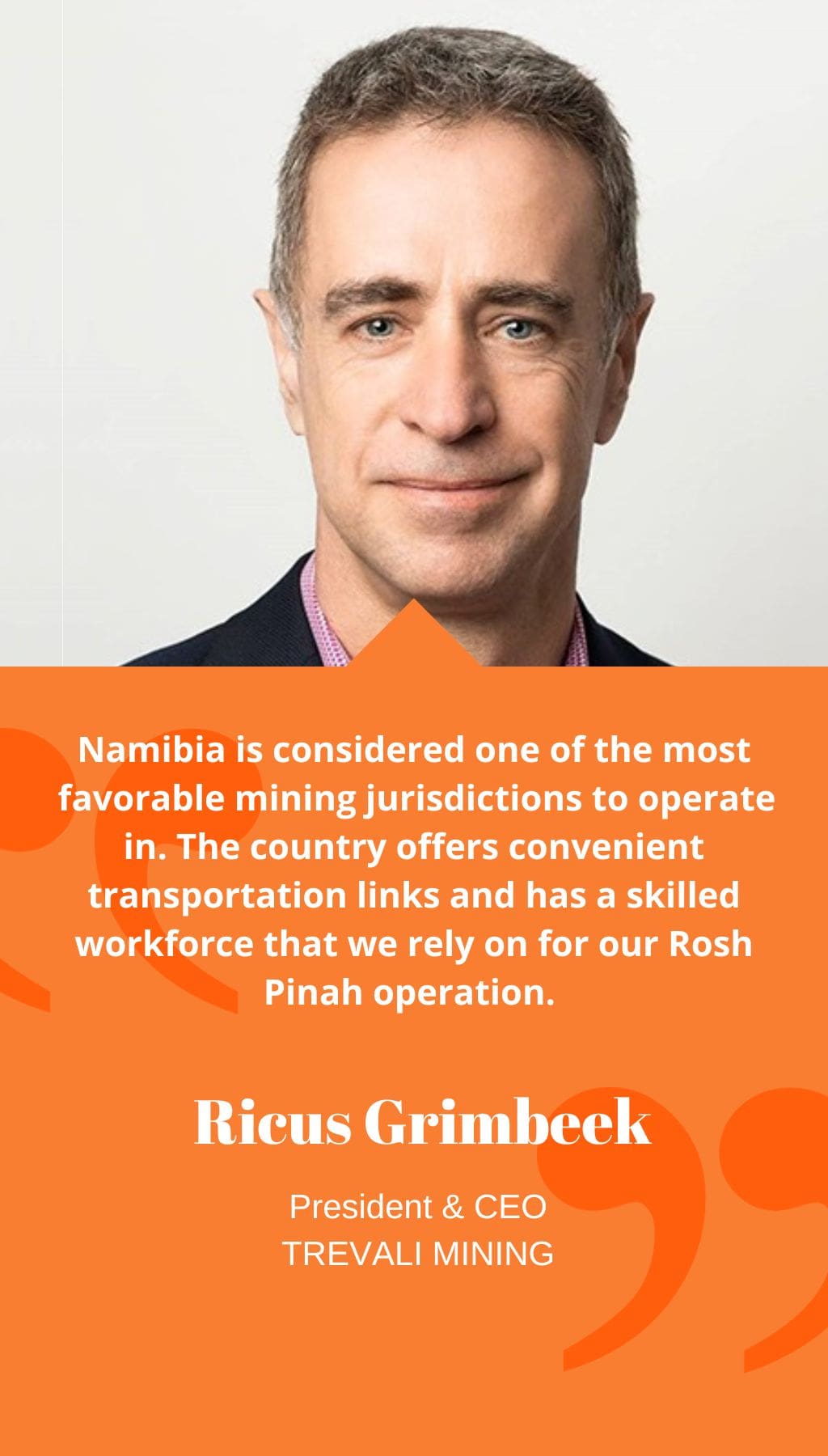
- Namibia | 19 August 2021

Can you provide an overview of Trevali’s assets and resource base worldwide?
Trevali currently operates four mines across different countries. These include the Santander mine in Peru, the Pekoa mine in Burkina Faso, the Caribou mine in Canada, and our flagship asset, the Rosh Pinah (RP) mine in Namibia. The majority of our revenue, around 85 to 90%, comes from the sale of zinc. We also generate additional revenue from lead and silver as by-products. In addition to our current operations, we are actively exploring around our mines to discover and define additional resources that can extend the life of our operations. Furthermore, we have a joint venture opportunity with Vedanta Resources at Gergarub in Namibia, which involves exploring a sulphide ore body.
What are the plans for the Rosh Pinah mine?
We have ambitious plans for the Rosh Pinah mine. Recently, on August 17, 2021, we published a Feasibility Study (FS) that examines the potential to nearly double production at the mine. The FS indicates that the expansion can be achieved with an all-in sustaining cost of 72 cents per pound of zinc and a mine life of 12 years. The execution of the expansion is expected to take place from 2022 onwards over a period of 24-36 months. Expanding the mine while it is in operation presents challenges, and to mitigate against these challenges, we are investing significant effort in developing a detailed project execution plan. Our goal is to transform Rosh Pinah into a world-class asset by adopting modern mining techniques and technology. For example, we have implemented automation systems in the processing plant to enhance recovery processes. We are also utilizing a semi-autonomous front-end loader underground, which improves safety and optimizes loading time. Data cleansing and analysis are conducted from our operational base in Vancouver, and we are planning to implement an integrated planning and scheduling system for production and maintenance at RP.
How is Trevali working towards reducing its environmental footprint?
We are committed to reducing our greenhouse gas emissions by 25% by 2025 compared to 2018 levels. To achieve this, we are implementing various initiatives across our portfolio. As part of the RP2.0 expansion project, we are aiming to have a smaller tailings footprint by pumping a significant portion of the tailings back underground through a paste backfill plant. Additionally, we have signed an agreement with Emesco to supply us with solar power, which will cover 30% of our energy consumption at RP. We have also focused on improving metallurgical recovery at the Perkoa mine, allowing us to process zinc more efficiently and reduce power consumption. Water recycling has also been a key area of our efforts.
Could you provide details about Trevali’s balance sheet structure?
We strive to maintain a production cost of 90 cents per tonne, although this is becoming increasingly challenging due to inflation and labor cost pressures. In the long run, our goal is to achieve operating costs of around 70 to 80 cents. In Q1 of 2021, we managed to reduce our net debt by US$12.4 million through various business improvement initiatives, an increase in the zinc price, and a reduction in benchmark treatment charges for the year.
We anticipate strong cash flows in the coming quarters, which will significantly strengthen our balance sheet and position us well for raising financing for the Rosh Pinah expansion.
How has the pandemic impacted the zinc market?
Prior to the pandemic, the zinc market experienced an oversupply of concentrate. However, during the outbreak, the smelters in China consumed the excess supply as global supply struggled, particularly in South America. Currently, we are observing a supply deficit as expansion projects were delayed and no new mines were developed. We expect this supply constraint to persist for several years, which will have a positive impact on zinc prices. Demand for zinc is expected to remain solid, driven by its use as a raw material in solar panels and its essential role in galvanization and infrastructure projects such as road construction.
What factors make Namibia an attractive mining investment destination?
Namibia is considered one of the most favorable mining jurisdictions to operate in. The country offers convenient transportation links and has a skilled workforce that we rely on for our Rosh Pinah operation. Moreover, there is an ongoing dialogue between mining companies and the government, which is quite rare. We consider ourselves fortunate to be operating in Namibia due to the supportive environment for mining activities.














